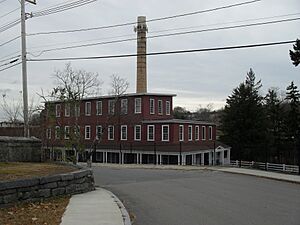Bernat Mill facts for kids
The Bernat Mill, also known as Capron Mill and later Bachman Uxbridge Worsted Company, was an American yarn factory in Uxbridge, Massachusetts. A large fire mostly destroyed it on July 21, 2007.
This factory complex in Uxbridge was a major center for Bernat, a company once based in Jamaica Plain, Massachusetts. Uxbridge became the main manufacturing spot for Bernat in the late 1900s. It was the third largest yarn factory in the U.S. The Bernat Mill and the town of Uxbridge played an important part in U.S. history and the story of American textile manufacturing.
"Bernat" is still a brand name for a company that makes yarn products today.
The Mill's Early Days
The first factory on this site was the Capron Mill, built in 1820. It was built by John Capron and his sons, Effingham and John, along the Mumford River in Uxbridge Center.
This mill was special because it used the first power looms for woolens in America. These machines were made in a workshop in Cumberland, Rhode Island. The Capron Mill also made the first "satinet" fabric, which was a type of shiny wool cloth. Uxbridge became famous for its Cashmere wool because of this mill. For over 140 years, the Capron Mill and later the Bachman Uxbridge Worsted Company made clothing and military uniforms for the United States.
A Big Name in Textiles
The mill became very famous as the Bachman Uxbridge Worsted Company. In 1953, it was even featured in Time magazine in an article called "The Pride of Uxbridge." It was one of the most successful textile mills in New England at that time.
The Bachman Uxbridge Worsted Company was started by Edward Bachman and Charles Arthur Root. This factory in Uxbridge was the main hub for seven other plants across the U.S. It employed over 6,000 workers. In the early 1950s, its special wool and synthetic fabrics were very popular in women's fashion.
The first woolen mill in the Blackstone Valley was built in Uxbridge in 1810. By 1953, the Bachman Uxbridge Worsted Company was almost ready to merge with another company to become the largest woolen maker in the U.S. Uxbridge became known for making woolen fabrics, creating a full process from raw textiles to finished clothing, and for new ideas in the textile industry. This was when production was at its highest in the early 1950s.
The company also did research to create new fabrics. One important fabric was the "wool-nylon serge" used for army uniforms. The original U.S. Air Force uniform was made at this factory. Its special blue color was even patented as "Uxbridge Blue" or "Uxbridge 1683." This blue dye was used for uniforms starting in 1947.
In 1948, President Truman approved the new blue Air Force uniform. The special "Uxbridge Blue" fabric was developed at the Bachman-Uxbridge Worsted Company. It was planned to be ready for distribution by September 1950.
Later, in 1954, Time magazine reported that the company planned to merge with American Woolen Co. This would have made them the biggest woolen manufacturer in the country. However, another company called Textron blocked this merger. Textron later became a large company based in Providence, Rhode Island. This was the last time Bachman Uxbridge tried to become the biggest woolen company in America.
By 1964, the Bachman Uxbridge assets were sold to Bernat Yarn of Jamaica Plain, Massachusetts. The mill's name then changed to the Bernat Mill. It became the third largest U.S. yarn mill. This mill made uniforms for the American Civil War, World War I, and World War II. Around 1968, Bernat also developed latch hook yarn kits here.
The 2007 Fire
Early on Saturday, July 21, 2007, a huge fire broke out at the historic mill. It caused a lot of damage to the complex on Mendon and Depot Street. About 600 firefighters from 66 different towns worked hard to put out the fire. But the building was almost completely destroyed. It took three days to fully extinguish the flames.
At the time of the fire, the large building was no longer a factory. It had been changed into spaces for 65 small businesses. The fire caused millions of dollars in losses for these businesses. Between 300 and 500 people lost their jobs.
After the Fire
Investigators found that some welding work was happening without permission. Also, the sprinkler system was not working. Both of these things helped the fire spread. The mill owners planned to rebuild the complex.
The way different towns and states worked together to respond to this disaster was seen as a great example for the region. Senator John Kerry helped get Small Business Administration loans to support the business owners affected by the fire. Governor Deval Patrick even left a meeting in Michigan to come back to Uxbridge and help with the recovery. Governor Patrick quickly got state and federal aid for the victims and businesses. Funds from Hurricane Katrina relief efforts were also used to help. As of 2009, plans to rebuild were on hold.
See also
- Blackstone River Valley National Heritage Corridor



